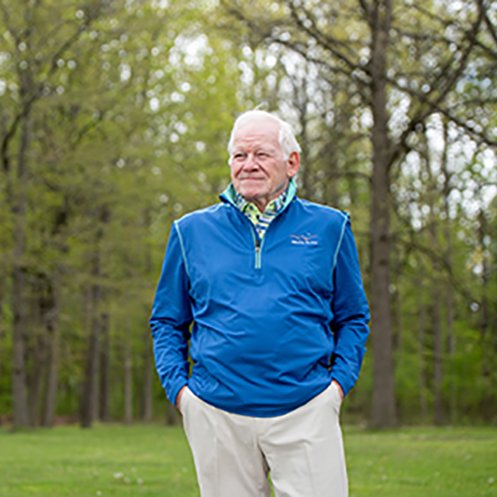Metastatic Brain Cancer
Stephen's brain tumor metastasized from melanoma in the leg.

When an article about skin cancer caught Stephen Bonetti’s attention, the detailed-oriented accountant glanced down at the freckle on his knee. His assessment was correct. At age 55 in 2002, the melanoma was removed. But a rogue cell had crept away from his knee. In 2010, Stephen felt a lump in his thigh. Treating the deadly cancer that knows no boundaries would ultimately involve a forerunning neurosurgeon.
The lump and several lymph nodes along Stephen’s thigh were removed to prevent the spread of cancer. Every weekday for a month, intravenous interferon stimulated Stephen’s immune system to attack any outlaw melanoma cells. “To keep myself calm, I listened to music– rock, pop and jazz,” says Stephen, who owns about 600 CDs.
“On the first day, I had the shakes, but every day afterwards it got better,” says Stephen. For the following 11 months, Stephen gave himself interferon injections.
Life was good for many years, says Stephen. He played sports and enjoyed travelling with his wife Dianne. But on a July evening in 2014 after playing golf and eating dinner, he suddenly couldn’t talk. An ambulance sped him to a nearby hospital where an MRI showed a brain tumor. Doctors told him to quickly plan for surgery.
After researching hospitals that treat brain tumors, Stephen was impressed with Henry Ford. “They had the latest technology, and it was explained very well on their website,” says Stephen, a Troy resident. One week later, he had another MRI and met with several cancer specialists on Henry Ford’s tumor board. The diagnosis: stage 3 metastatic melanoma to the brain.
 During stereotactic radiosurgery, radiation was delivered precisely and non-surgically to protect healthy brain tissue. “It only took about 20 minutes,” recalls Stephen. “They put a molded mask on my face, bolted it down and then gave me a zap of radiation.” Salim Siddiqui, M.D. was the radiation oncologist on Stephen's case.
During stereotactic radiosurgery, radiation was delivered precisely and non-surgically to protect healthy brain tissue. “It only took about 20 minutes,” recalls Stephen. “They put a molded mask on my face, bolted it down and then gave me a zap of radiation.” Salim Siddiqui, M.D. was the radiation oncologist on Stephen's case.
“Not too many things bother him,” says Dianne, his wife of 51 years. “He has a good temperament.”
On a return visit, the tumor appeared slightly smaller. Later it grew, then it shrunk, then it grew.
It was acting like radiation necrosis. Radiation necrosis is the death of healthy cells following radiation therapy, and only 5 percent of patients develop it.
Symptomatic radiation necrosis can be very difficult to treat, says Ian Lee, M.D., neurosurgeon and cancer researcher. When other treatments are ineffective, an open craniotomy can be done. But there’s a high risk of infection and long recovery time. Also, the tumor had been near the speech area of Stephen’s brain, so a craniotomy could affect his speech. Laser ablation is less invasive, but it’s not commonly done.
Henry Ford is one of the busiest centers in the U.S. for tumor ablation. And it has the nation’s second largest – and one of the oldest – tumor banks. Tissue samples have been collected and studied there for 30 years to find a cancer cure.
“On the day of the planned laser ablation, we were all prepped and ready to go, when Dr. Lee came into the operating room with the MRI report and said the tissue had shrunk again,” says Stephen. At the last minute, surgery was cancelled.
“The doctors were willing to give it a little time and see what happened,” says Diane who had been sitting in the waiting room with their son. “I really respect them for that.”
Two months later, Dr. Lee performed laser ablation surgery. A small opening in the skull was made, and MRI imaging precisely directed light energy from the laser onto the necrotic tissue. The little incision required only two stitches, making recovery faster. “In this case, laser ablation was as effective as open surgery,” says Dr. Lee.
“Because the technology was so great, I wasn’t scared. I have a great wife who helped me through all this” says Stephen. “And everyone on the Henry Ford team was great.” Stephen’s team included surgeon S.D. Nathanson, M.D., medical oncologist Sheela Tejwani, M.D. and neuro-oncologist Tobias Walbert, M.D.
“Patients seek us out because they are looking for advanced treatment options. They don't want to just do nothing.” says Dr. Lee. “When people are told they have a tumor that is inoperable, that’s not always the case. With laser ablation, we offer surgical treatments that might otherwise be risky for infection, stroke or other neurological side effects.
 “Stephen is very realistic and pragmatic. The typical survival for metastatic melanoma to the brain is less than one year. Yet Stephen continues to be disease free. It is very, very unusual for him to be alive and doing well and disease free seven years after his diagnosis of metastatic melanoma to the brain.”
“Stephen is very realistic and pragmatic. The typical survival for metastatic melanoma to the brain is less than one year. Yet Stephen continues to be disease free. It is very, very unusual for him to be alive and doing well and disease free seven years after his diagnosis of metastatic melanoma to the brain.”
Says Stephen, “I’m happy everything worked out just fine. I highly recommend the Hermelin Brain Tumor Center at Henry Ford. I can’t say enough about the doctors and the surgery. Thank God, I was in the right place at the right time to get good care at Henry Ford.”
Stephen’s future? Yearly MRIs, spending time with his wife, making pancakes for his three grandkids and golfing.
His advice? Have a positive attitude, maintain a healthy lifestyle, and listen to lots of music, says the smiling 74-year-old. “Most people are positive, but if someone is negative, tune it out or walk away. Finally, try to make every day better than the last day.”

Stephen's brain tumor metastasized from melanoma in the leg.
We use cookies to improve your website experience. By using this site, you agree to our Terms of Use. Read our Internet Privacy Statement to learn what information we collect and how we use it.